अभिक्रिया N2(g)+3H2(g)↔2NH)(3(g)),ΔH<0 में अमोनियम के उत्पाद की समय पर निर्भरता (P, T1) पर नीचे दर्शायी गयी है।
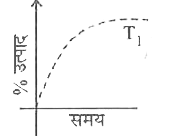
A
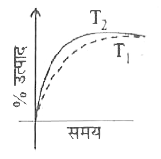
B
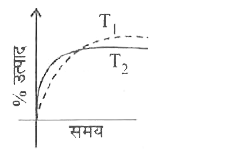
C
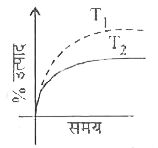
D
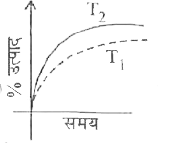
Text Solution
The correct Answer is:(b)
तापमान बढ़ाने पर प्रारम्भ में अभिक्रिया की दर में वृद्धि होती है,अत:% लब्धि समय के साथ बढ़ती है, परन्तु साम्य पर उच्च ताप (T2) पर % लब्धि T1 की तुलना में कम होगीयद्यपि अभिक्रिया उष्माक्षेपी है। इस प्रकार ग्राफ निम्न है
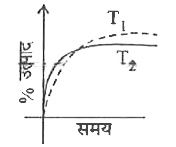
|
Topper's Solved these Questions
- रासायनिक बलगतिकीBOOK - MITTAL PUBLICATIONCHAPTER - रासायनिक बलगतिकीEXERCISE - बहुविकल्पीय प्रश्न
35 Videos
- बहुलक BOOK - MITTAL PUBLICATIONCHAPTER - बहुलक EXERCISE - विभिन्न प्रतियोगी परीक्षाओं में पूछे गये प्रश्न
40 Videos
- विघुत रसायन BOOK - MITTAL PUBLICATIONCHAPTER - विघुत रसायन EXERCISE - विभिन प्रत्योगी परीक्षा में पूछे गए प्रश्न (बहुविकल्पीय प्रश्न )
33 Videos
Similar Questions
Knowledge Check
Given
N2(g)+3H2(g)=2NH3(g),ΔH∘=−22kcal. The standard enthapy of formation of NH3 gas isA−11 kcal/molB11 kcal /molC−22 kcal/molD22 kcal/molConisder the chemical reaction
N2(g)+3H2(g)→2NH3(g)
The rate of this reaction can be expressed in terms of time derivatives of the concentration of N2(g),H2(g), or NH3(g). Identify the correct relationship among the rate expresisons.Arate =−d[N2]/dt=−1/3d[H2]/dt=1/2d[NH3]/dtBrate =−d[N2]/dt=−3d[H2]/dt=2d[NH3]/dtCRate =d[N2]/dt=−3/3d[H2]/dt=1/2d[NH3]/dtDrate =d[N2]/dt=−d[H2]/dt1/2s[NH3]/dtFor this reaction
N2(g)+3H2(g)→2NH3(g)
The relation between d(NH3)dt and −d(H2)dt is :-Ad[NH3]dt=−13d[H2]dtB+d[NH3]dt=−23d[H2]dtC+d[NH3]dt=−32d[H2]dtDd[NH3]dt=d[H2]dt
